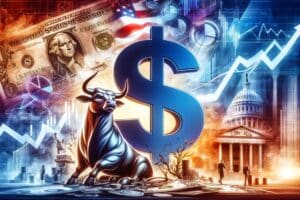The US dollar has returned to being strong, after the release of last week’s US labor market data.
In fact, from May 30 to Friday, June 7, the Dollar Index had dropped from 105.1 points to 104.1, but then not only returned above 105 points, but also rose today above 105.2.
The current level has not been seen since mid-May, that is, for almost a month during which it has often fluctuated just above 104.5 points.
Indeed, until Friday it seemed that a slight medium-term downward trend was in place, which however was interrupted on Friday.
The Dollar Index
The Dollar Index, also known as USDX or DXY, is simply a measure of the value of the US dollar not against another single currency, but against a basket of foreign currencies.
This basket is composed of six foreign currencies, euro, Japanese yen, British pound, Canadian dollar, Swedish krona, and Swiss franc, but does not include the Chinese yuan.
Of these six currencies, the euro has the greatest weight within the index, with as much as 57.6%, followed by yen (13.6%), pound (11.9%), and Canadian dollar (9.1%).
Generally, when its value rises, it means that speculators in the financial markets sell assets to buy dollars, although the variation in the exchange rate with the euro also obviously has a significant impact.
In fact, shortly after Friday’s jump, the price of Bitcoin for example started to fall, then dropping in a few minutes from about $72,000 to about $69,000.
Since the beginning of the year, the Dollar Index has risen significantly, given that it had closed 2023 at 101.4 points.
This rise, however, occurred in two specific periods: in January and early February, reaching 104.9 points, and then in the first half of April, when it also rose above 106.4 points.
Since then, it seemed that a downward trend had been triggered, which in fact had brought it back to 104 points last week, and which instead might have been interrupted on Friday.
The current value is still relatively high compared to the 2024 series, although not yet close to the annual highs.
It should not be forgotten, however, that during the bear-market of 2022 it had even reached 114 points, a value that had not been seen for twenty years.
A proxy of fear
Given that the Dollar Index often rises when other assets are sold on financial markets, it can be used as a proxy for short-term fear.
In fact, in case of fears for the long term, gold is generally purchased, but if it is sold only with the intention of buying back later at lower prices, then it is much better to purchase US dollars.
Taking into consideration the last 5 years, before the outbreak of the pandemic the Dollar Index was at 99 points, significantly lower compared to current levels. At the time of the financial markets crash in March 2020, it shot up to 103.2 points in just a few days, but with the Fed’s QE it started to decline sharply, reaching 89.8 points in December of the same year.
During the second half of 2021, it started to rise again to return to pre-pandemic levels, and then from March 2022 to reach new decade highs in October.
This rise was a clear sign of both the short-term fear circulating in the financial markets at that time and the bear-market in progress.
What is surprising, however, is that it has never returned to pre-pandemic levels, although in July of last year it came close.
US Job Market: The Reason for the Dollar’s Rise
The rise on Friday, which could also mark a trend reversal compared to the decline of the past few weeks, was triggered by positive news on the US job market.
The reason is simple: the better the US economy performs, the higher the risks of inflation, making it more difficult for the Fed to cut rates.
Financial markets depend heavily on the liquidity injected or withdrawn from circulation, so a restrictive monetary policy by the main central bank of the world ends up having bearish effects.
At the moment when the markets understood that, due to the good pace at which the US economy is proceeding, the prospects for the first Fed rate cut are moving away, they reacted badly, and the rise of the Dollar Index only shows a clear increase in fear in the medium-short term.
It should not be forgotten that the indices of the USA stock exchanges are still close to their highs, with the S&P500 having set the record just on Friday.
In such a scenario, it is expected that the Fed will start cutting rates, or that liquidity in the financial markets will increase again, but such confidence can be questioned by the Fed, which might instead opt for a continuation of its current restrictive monetary policy.


